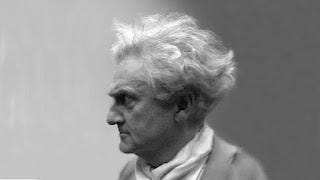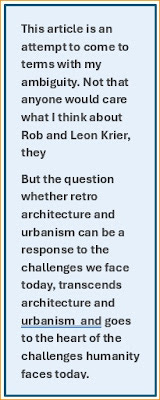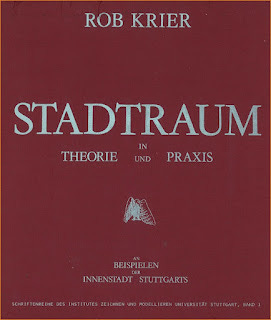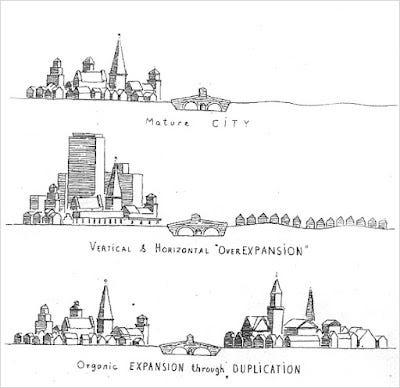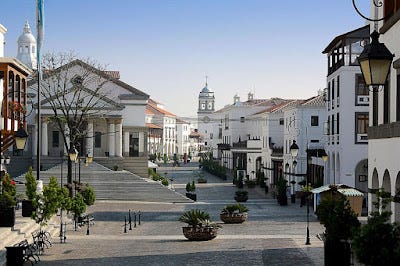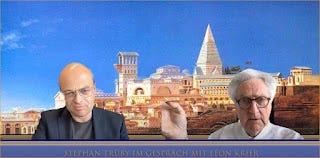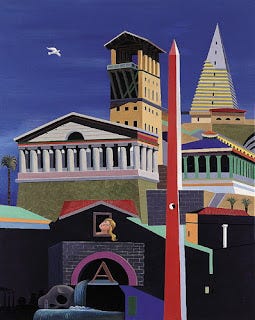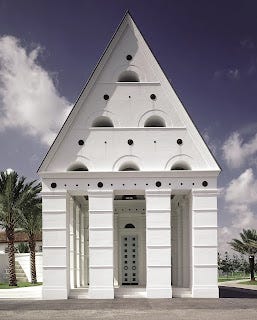Leon Krier 1946-2025 - Not a Eulogy
"The most important thing in life is to never make compromises (...) because accepting compromises means losing. I have seen it in all my friends who build." (Leon Krier per Architecture Viva)
The Back Story
Leon Krier who died in June this year at age 79 had admired his eight years older brother Rob who died in 2023 age 85. Both were architects and both derided modernist architecture and urban design as an
Leon Krier image: Furiously determined, classical
abomination. Both were outsiders swimming upstream at a time when almost all architects were fervent modernists. In spite of this the elder brother stayed in architecture school long enough to receive a degree, while Leon fled Stuttgart's university after a year without a degree which didn't stop him from becoming anenfant terriblein the international architectural community, or as he saw it, a prophet in the wilderness. In the end it was the younger Leon who got an obituary in the New York Times, not Rob.
The lack of a degree didn't stop the younger Leon to work in reputable architecture firms and even teach at universities. Eventually he landed a very high profile project with Poundbury, a British New Town designed in the style of traditional English village. Its master planning was commissioned to Krier by nobody less than Prince Charles, now the King. Krier designed buildings tend to be rather funny creature that seem to have jumped off the pages of his cartoon style drawings.
"When I set out on this venture, I was determined that Poundbury would break the mould of conventional housing development in this country" (King Charles)
Poundbury is now a place of more than 4000 residents, very cute and so retro, that the garages are too small for contemporary cars. Leon wrote books and endlessly produced entertainingly polemic sketches illustrating the fallacies of modernism and modern planning. His missionary attitude fell on fertile ground not only with Prince Charles but also with with the architect pair of Andres Duany and Plater Zyberk who popularized Krier's beliefs under the term New Urbanism, originally materialized in the small towns of Seaside Florida and Kentlands, outside Washington DC. New Urbanism eventually influenced new suburbs across the country. The Congress of New Urbanism took place 33 times, three times as often than its nemesis, Congrès Internationaux d’Architecture Moderne, Duany proudly notes in his eulogy for Krier.
Our civilization has lost both a pillar and a buttress: one a brave, brilliant, and uncompromising architect, Krier; the other a warm, funny, and generous friend and mentor, Leo.(Andres Duany)
Both Kriers spent time at the Stuttgart University, my alma mater. Which brought them to my attention early in my life. during my time Rob Krier was teaching assistant to professor Johannes Uhl who taught design and interiors. When I started paying attention to Stuttgart's auto-centric post-war design, an analysis of Stuttgart's spaces before and after the war drawn up by Rob Krier in his book "The Theory and Practice of Urban Space" caught my attention, but also derision for its notions of classical order.
Rob Krier: Urban Space, Stuttgart analyzed
Now it looks to me like a very thoughtful analysis. My aversion to the classicist approach and anything the Krier brothers propagated did not subside easily. It was fueled again when Leon wrote a book about Albert Speer, Hitler's house architect, and undertook a book tour in 2009. It only confirmed for me that the Kriers were hung up on imperialist Roman patterns that were also the models for fascists. In 2009 e-mail exchange with fellow architects who wanted to go to one of Leon's lectures I wrote:
I agree with Krier (gasp!) in one point: Modernism has failed cities. Modernism has advanced building design, technology and style but it hasn't brought much in terms of plausible or desirable urban form.
But beyond that, I'd like to send Krier on a long journey to China, South America, Africa and India where the action is. The euro-centric debates emanating around the pre-senile Prince Charles are irrelevant.
The world's population is rapidly expanding with over 2/3 people now living in urbanized areas. No way that Poundbury can be the solution for Hongkong, Shanghai, Mumbai, Sao Paulo or Kinshasa. Rem Koolhaas (for example) has so infinitely much more to say about this than Krier, its not even funny.
Thus, the Krier brothers loomed large as antagonists in my life as an architect, even though, I also devoted much of my time to deride spawl, automobilism and propagating a different urbanism.
Leon Krier sketch commentary
I did attend a Leon Krier lecture here, I think it was at the University of Maryland and found Leon's pontifications still only mildly entertaining and eventually as grating as the current President's edict that government architecture has to be classical. In matters outside architecture Krier could be even further off the wall. Krier knew how to provoke:
"Hitler and Bill Gates will one day hang in the same gallery" (Leon Krier in a conversation with Stephan Trueby about Atlantis, a Krier design for intellectual elites on Teneriffa conceived by German gallery owners. He mentioned this in the context of "corona terror" and a "Davos conspiracy")
Professor Trüby, a faculty member of the University of Stuttgart, brought Krier's death to my attention through his Facebook post in which he expressed his own mixed feelings about Krier with whom he had stayed in contact:
I always valued him as an "agent provocateur" and illustrative polemicist, and even though I wrote a lot of critical things about him, his Speer book, and his reconstruction obsession, in recent years we have, while maintaining our differences, developed a lively, almost friendly correspondence. He was a great, broadly educated architect with a talent for elliptical and, moreover, sometimes mercilessly topical phrases like: "I don't build because I'm an architect." Ultimately, I believe he thrived primarily on friction. That has become a rare virtue among us perpetually offended people with a full "safe space" pension. Paradoxically, then, a longing for debate lay behind his seemingly consensus orientation in the form of classical and traditional architecture.(Professor Stephan Trüby on his
Cayala, Guatemala (See also the NYT)
Recklessness had gotten Krier in trouble when he wrote abook about Albert Speerand justified his architecture with statements such as "the dictators die but the architecture survives", thus divorcing either power from architecture or ignoring the intimidating intent of Speer's and Hitler's architecture.
My Question
Krier's death struck a nerve, though, and made me do some more research about the man to see whether he wasn't right in some ways, after all. Haven't I subscribed to some of the New Urbanist principles of buildings facing narrower streets, to human centric design, to resource and energy conservation, permanence over throw away architecture and walking over driving? Haven't I proposed historic preservation as early as 1975? Haven't I named my blog "Community Architect" around the same time Leon Krier published his book "Architecture of Community"(I book I only discovered now)? Haven't I long realized that what makes our cities isn't all rational and data based and that people rightly expect from architects physical and emotional comfort? Wasn't my contention that modern buildings are good but modern urbanism isn't an untenable, even illogical and contradictory position? Couldn't be my entire antagonism to the Kriers be nothing but a misunderstanding?
Krier sketch: The car as the anti-urban weapon of the suburb
This article is an attempt to come to terms with my ambiguity. Not that anyone would care what I think about Rob and Leo Krier, they got glowing reviews and achieved immortality, regardless. But the question whether retro architecture and urbanism can be a response to the challenges we face today, transcends architecture and urbanism and goes to the heart of the challenges humanity faces today where "retro" is offered as a solution in so many circumstances way beyond the built environment.
First I found this astonishing 1-3/4 hr long virtual interview on Archifeed, a relatively obscure podcast, conducted by a young man that took place only weeks before Krier's death. In this intimate setting at his kitchen, Krier reveals himself less as a provocateur and more as a real reactionary.
Leon Krier in May 18, 2025 interview on ArchiFeed
His ailment unnoticeable in his lucidly pleasant conversation style, his stream of talking is interrupted several times by him cackling about something funny. He covers a broad swath of his world view, repeating his take on Speer's architecture going as as far as stating that Hitler himself designed the fortifications of the "west wall" which he called "very beautiful" and the inspiration for Corbusier's "beton brut". While this may be one of his provocations, no matter how unproven and of bad taste this assertion may be, a bit later he went on and called all modern music and art "complete decadence". This reveals a reactionary streak. He also repeated his most outlandish notion that Covid was "propaganda".
But he also tells the young man that natural materials teach craftsmanship while concrete and steel do not; they not only depend on fossil fuel but also corrupt the designer, he says. He maintains that people love reconstructions such as the "New Castle" in Berlin and that his views are gaining popularity. At the time of the interview he already knew that he was "in a treatment with uncertain outcome" for what was described after his death a few weeks later as an untreatable type of colon cancer. In spite of his pronouncements, he didn't come across as a cranky old man but seemed to be in a good mood and said as much:
Screenshot of the Atlantis interview with a rendering
of the town in the background
I am almost 80 and I draw every day and am a very happy person. My modernist friends, they are all frustrated, they know modernism has no future (Leon Krier in a June 2025
Trüby's post also helped me find this ARCH+ video in which Trüby investigates the story of Atlantis on Tenerife from which I quoted above. And of course, I looked up the eulogies and obituaries after his death that for the most part followed the maxime: De mortuis nihil nisi bene (Of the dad speak only well).
My Take-Away
Even though the two interviews confirmed my suspicion that Krier was not limiting his "retro" views to architecture and planning, what he says is not just a matter of true or false or of progressive versus reactionary. Poundbury certainly can't be scaled up and anything like it wouldn't work in China, Africa or India just as I said in 2009, neither should Chandigarh, La Defense or Tysons Corner, even though the latter has been tried often enough. While many of Leon Krier's statements are indefensible, he still puts the finger on many sore points of current architecture and planning, even though his assumption that all mainstream architects are modernists has long become obsolete.
A graphic depicting parts of Atlantis
Anyone with open eyes can see that 90% of what architects and planners created since modernism set the world on edge is utterly forgettable. This may have been the case for individual buildings of any period, but with 9 billion people the built environment has become too big to be predominantly ugly, wasteful with energy, time, space, material and resources. The "Geography of Nowhere" at the periphery of any city, the clusters around Interstate exits, industrial parks, shopping centers or most subdivisions are not only a visual assault, but also dysfunctional, destructive and short lived.
Where New Urbanist principles reined in the chaos in new mixed-use town centers, redeveloped malls or transit station developments from Cherry Creek in Colorado to Reston in Virginia, or Silver Spring in Maryland, some of Krier's lessons have been applied, even though many who follow New Urbanism, Strong Towns or many other currently popular schools of place-making may not even know about Krier. These artificial town centers are not always convincing, but they are better than what they replaced for featuring places that are more than the distance between buildings or storage area for the automobile. Many of these new urbanist inspired developments also prove that using traditional concepts for ordering things doesn't have to mean classical style buildings that can't be taller than five stories.
Beauty, Krier says and science confirms it, isn't just in the eyes of the beholder; it follows certain perceptions that humans either carry in their DNA or learn early on in their respective culture. The specifics of the learned esthetics are not universal. Nobody should be entitled to export them globally, as modernists certainly did. The Greek-Roman western ethics of the Krier brothers can't be applied universally either, even though Leon Krier may somehow have believed that. In 1984 he was happy to design Atlantis, the town in Tenerife he envisioned as place where (western) intellectual elites would meet and somehow "reform Western civilization to ensure the survival of our societies beyond the coming millennium", a colonial sound, for sure.
Krier chapel and town hall in Windsor
Florida. (Architecture Viva, Dan Forer)
India, South America, Asia, and Africa have to find their own solutions,neither carbon copies of modernism nor of western classicism, both have governed former colonies long enough. The Krier inspired enclave of Cayala in Guatemala can serve as an admonition. Krier, the master planner ultimately resigned.
“Skyscraping is, I think, an immoral act.” (Krier)
His resignation came not because this has become a place for the elite (like Atlantis) in a poor and violent country, but because commercial interest inserted itself with the desired to build taller buildings.
Rifle-grasping guards squint at each passerby, sizing up potential assailants. Smoke-belching buses barrel through stop signs. But tucked within the chaotic capital’s crazy-quilt sprawl, there is a dreamlike haven where none of that exists. In the City of Cayalá, a utopian domain created by one of Guatemala’s richest families, the streets are quiet and orderly, the stores are upscale and the homes attainable — if only to families from the country’s small, moneyed elite. (NYT)
Shanghai, Hong Kong, Mumbai, Dubai Dhaka and Mexico City and many other cities are, indeed, blazing pathways that are innovative and genuinely new. Generally more modernist than classicist these developments occur on a scale we can barely imagine. Neither Leon or Robert Krier's recipes work for that, nor do Frank Lloyd Wright or Corbusier's. Krier's notion that no building should be over five or six stories is or not be made of concrete and steel is not useful for a city of 10 million residents or more. The dichotomy between modernism and classicism has long ended. But some of the values which the Kriers embraced, such as “human centric design” the “15 minute city”, local materials, energy conservation, durability and resilience are universal, nevertheless.
Klaus Philipsen, FAIA
https://architecturehereandthere.com/2022/04/19/atlantis-kriers-ideal-village/
(UMiami Lecture) Sept 15, 2009
https://www.nytimes.com/2024/01/18/world/americas/cayala-guatemala.html




